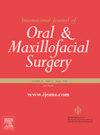Validation of ‘total face approach’ (TFA) three-dimensional cephalometry for the diagnosis of dentofacial dysmorphisms and correlation with clinical diagnosis
IF 2.2
3区 医学
Q2 DENTISTRY, ORAL SURGERY & MEDICINE
International journal of oral and maxillofacial surgery
Pub Date : 2024-10-11
DOI:10.1016/j.ijom.2024.10.002
引用次数: 0
Abstract
The last decades have witnessed significant improvements in orthognathic surgery, but a true standardization of cephalometric analysis to guide clinical assessment in three-dimensional (3D) virtual planning is still lacking. Therefore, the aim of this study was to validate the ‘total face approach’ (TFA) 3D cephalometric model for the diagnosis of dysmorphia and to analyse its correlation with the clinical diagnosis and virtual surgical planning performed in the Maxillofacial Surgery Clinic in Udine. This model was validated by studying different cephalometric points in three modules (vertical dimensions, sagittal dimensions, and symmetry) and their sections. Each section of the different modules evaluates the range of the studied patient according to the TFA analysis executed in Planmeca Romexis software and compares it with the ProPlan CMF data. The results of the statistical analysis defined the degree of concordance for each point studied. An overall high correlation was demonstrated for each of the cephalometric categories (weighted kappa between 0.442 and 0.642 in vertical dimension, between 0.587 and 1 in sagittal dimension, and between 0.773 and 1 in symmetry). The TFA model can be considered a valuable guide for the diagnosis of dysmorphia and 3D virtual planning of orthognathic maxillofacial surgery.
验证 "全脸法"(TFA)三维头颅测量法在牙面畸形诊断中的应用以及与临床诊断的相关性。
在过去的几十年中,正颌外科手术有了长足的进步,但在三维(3D)虚拟规划中仍缺乏真正标准化的头颅测量分析来指导临床评估。因此,本研究旨在验证用于诊断畸形的 "全脸方法"(TFA)三维头颅测量模型,并分析其与乌迪内颌面外科诊所的临床诊断和虚拟手术规划的相关性。通过研究三个模块(垂直维度、矢状维度和对称性)中不同的头测点及其截面,对该模型进行了验证。根据 Planmeca Romexis 软件中执行的 TFA 分析,不同模块的每个部分都对所研究患者的范围进行了评估,并与 ProPlan CMF 数据进行了比较。统计分析结果确定了每个研究点的一致性程度。每个头颅测量类别的总体相关性都很高(垂直维度的加权卡帕值在 0.442 和 0.642 之间,矢状维度的卡帕值在 0.587 和 1 之间,对称性的卡帕值在 0.773 和 1 之间)。TFA 模型可被视为畸形诊断和颌面正颌手术三维虚拟规划的重要指南。
本文章由计算机程序翻译,如有差异,请以英文原文为准。
求助全文
约1分钟内获得全文
求助全文
来源期刊
CiteScore
5.10
自引率
4.20%
发文量
318
审稿时长
78 days
期刊介绍:
The International Journal of Oral & Maxillofacial Surgery is one of the leading journals in oral and maxillofacial surgery in the world. The Journal publishes papers of the highest scientific merit and widest possible scope on work in oral and maxillofacial surgery and supporting specialties.
The Journal is divided into sections, ensuring every aspect of oral and maxillofacial surgery is covered fully through a range of invited review articles, leading clinical and research articles, technical notes, abstracts, case reports and others. The sections include:
• Congenital and craniofacial deformities
• Orthognathic Surgery/Aesthetic facial surgery
• Trauma
• TMJ disorders
• Head and neck oncology
• Reconstructive surgery
• Implantology/Dentoalveolar surgery
• Clinical Pathology
• Oral Medicine
• Research and emerging technologies.

 求助内容:
求助内容: 应助结果提醒方式:
应助结果提醒方式:


